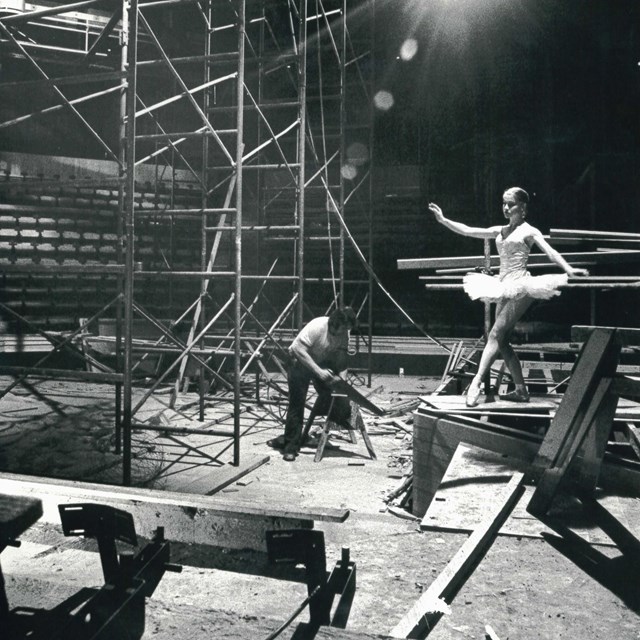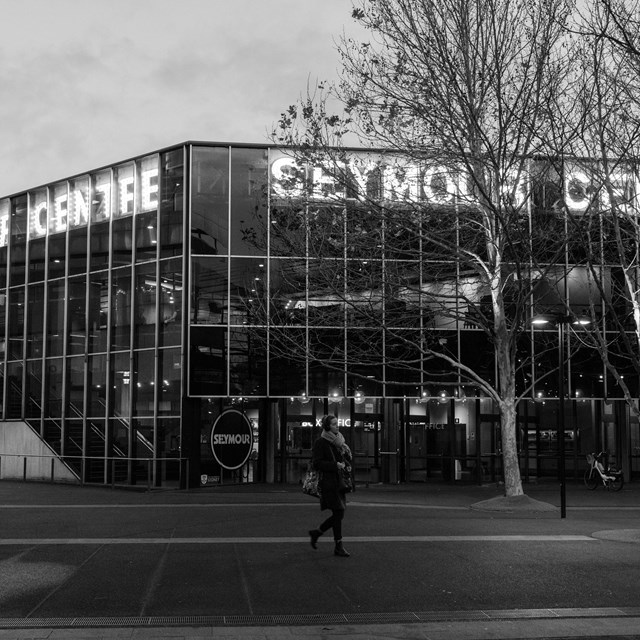A love story for the ages
Five fascinating facts about Romeo and Juliet, Shakespeare’s most famous tragedy
No love story has stood the test of time quite like Shakespeare’s Romeo and Juliet.
A tale of star-crossed lovers and an age-old vendetta between two powerful families, this legendary play remains immensely popular with audiences the world over, more than 400 years after its debut.
Sport for Jove’s brand new production of Romeo and Juliet opens at the Seymour in July, so we thought we’d unearth some interesting facts about this iconic tragedy, and dig deeper into its enduring influence on our culture.
Something old, something new
As with his other tragedies, Shakespeare drew inspiration for Romeo and Juliet from a pre-existing text, in this case The Tragical History of Romeus and Juliet, penned by English writer, Arthur Brooke, and published in 1562.
In turn inspired by an older Italian novella, The Tragical History of Romeus and Juliet was a narrative poem featuring the key elements we know so well – feuding families, young lovers, and a doomed romance – but as always, Shakespeare added his own unique flair to the story, fleshing out various characters and adding key plot points including the famous sword fight scene.
Do you bite your thumb at us, sir?
The core tension in Romeo and Juliet stems from the long-standing feud between the Montagues and the Capulets, but did you know that these families actually existed in real life, and that Shakespeare wasn’t the first writer to take them as inspiration?
Two wealthy Italian clans, the Montagues and the Capulets fought one another for power and political supremacy in 13th century Verona, and made such a cultural impression that they were also included in Dante’s 14th century masterpiece, the Divine Comedy, where they’re referred to by their Italian names of Montecchi and Cappelletti.
A rose by any other name
The names of Shakespeare’s plays are usually quite punchy, but this wasn’t always the case for Romeo and Juliet, which was originally published as The Most Excellent and Lamentable Tragedy of Romeo and Juliet. Quite a mouthful!
Scholars aren’t certain when the play took on the shorter-form title we’re familiar with today, and can’t be sure if the change was intentional or perhaps just a natural process of abbreviation, with the shortened name used more and more widely over time.
What light through yonder window breaks?
When we modern audiences think of Romeo and Juliet, one defining image – the balcony – often springs to mind. And given the iconic status of this scene, where Romeo and Juliet profess their love in the moonlight, it can come as a surprise to realise there’s actually no balcony in the text of the play.
In fact, the word ‘balcony’ appears in none of Shakespeare’s writings, and balconies didn’t even exist as a concept in 16th century England. Instead, Romeo and Juliet’s ‘balcony’ tryst traditionally took place at a window, with the balcony element only added during 18th century performances of the play, inspired by a scene in English playwright Thomas Otway’s The History and Fall of Caius Marius – which was, ironically, a Romeo and Juliet knock-off itself!
Wherefore art thou... female actors?
We know that women were excluded from the arts for centuries, often forbidden from attending the theatre entirely let alone performing on stage themselves.
This was particularly true in Shakespeare’s time, and despite Romeo and Juliet featuring a female lead, it would take nearly a century for a woman to step into the highly coveted role of Juliet Capulet. In 1662, English actress Mary Saunderson became the very first woman to play Juliet on stage, some 70 years after the play premiered.
Young hearts and minds
Although written 400 years ago, Romeo and Juliet continues to resonate deeply with contemporary audiences, remaining a timeless story of fate, chance, and first love.
Sport for Jove’s Artistic Director, Damien Ryan, believes the play holds an important message about our youth, reminding us that ‘children (with young minds, hearts, and intuitions) need to be heard and acknowledged by those that hold power. The inheritors of our moral and literal pollutions have a right to reject what the older generation is leaving behind for them to sort out, whether it be a feud between hateful families or the future of the ice caps.’
Find out more about Sport for Jove’s production of Romeo and Juliet here, and if you have any interesting Romeo and Juliet facts to share, let us know! We’d love to hear them.
Image credit: Seiya Taguchi
29 April 2022
Book your tickets to see one of the most iconic love stories of all time, Romeo and Juliet, at Seymour Centre.
BUY TICKETSNo love story has stood the test of time quite like Shakespeare’s Romeo and Juliet.
A tale of star-crossed lovers and an age-old vendetta between two powerful families, this legendary play remains immensely popular with audiences the world over, more than 400 years after its debut.
Sport for Jove’s brand new production of Romeo and Juliet opens at the Seymour in July, so we thought we’d unearth some interesting facts about this iconic tragedy, and dig deeper into its enduring influence on our culture.
Something old, something new
As with his other tragedies, Shakespeare drew inspiration for Romeo and Juliet from a pre-existing text, in this case The Tragical History of Romeus and Juliet, penned by English writer, Arthur Brooke, and published in 1562.
In turn inspired by an older Italian novella, The Tragical History of Romeus and Juliet was a narrative poem featuring the key elements we know so well – feuding families, young lovers, and a doomed romance – but as always, Shakespeare added his own unique flair to the story, fleshing out various characters and adding key plot points including the famous sword fight scene.
Do you bite your thumb at us, sir?
The core tension in Romeo and Juliet stems from the long-standing feud between the Montagues and the Capulets, but did you know that these families actually existed in real life, and that Shakespeare wasn’t the first writer to take them as inspiration?
Two wealthy Italian clans, the Montagues and the Capulets fought one another for power and political supremacy in 13th century Verona, and made such a cultural impression that they were also included in Dante’s 14th century masterpiece, the Divine Comedy, where they’re referred to by their Italian names of Montecchi and Cappelletti.
A rose by any other name
The names of Shakespeare’s plays are usually quite punchy, but this wasn’t always the case for Romeo and Juliet, which was originally published as The Most Excellent and Lamentable Tragedy of Romeo and Juliet. Quite a mouthful!
Scholars aren’t certain when the play took on the shorter-form title we’re familiar with today, and can’t be sure if the change was intentional or perhaps just a natural process of abbreviation, with the shortened name used more and more widely over time.
What light through yonder window breaks?
When we modern audiences think of Romeo and Juliet, one defining image – the balcony – often springs to mind. And given the iconic status of this scene, where Romeo and Juliet profess their love in the moonlight, it can come as a surprise to realise there’s actually no balcony in the text of the play.
In fact, the word ‘balcony’ appears in none of Shakespeare’s writings, and balconies didn’t even exist as a concept in 16th century England. Instead, Romeo and Juliet’s ‘balcony’ tryst traditionally took place at a window, with the balcony element only added during 18th century performances of the play, inspired by a scene in English playwright Thomas Otway’s The History and Fall of Caius Marius – which was, ironically, a Romeo and Juliet knock-off itself!
Wherefore art thou... female actors?
We know that women were excluded from the arts for centuries, often forbidden from attending the theatre entirely let alone performing on stage themselves.
This was particularly true in Shakespeare’s time, and despite Romeo and Juliet featuring a female lead, it would take nearly a century for a woman to step into the highly coveted role of Juliet Capulet. In 1662, English actress Mary Saunderson became the very first woman to play Juliet on stage, some 70 years after the play premiered.
Young hearts and minds
Although written 400 years ago, Romeo and Juliet continues to resonate deeply with contemporary audiences, remaining a timeless story of fate, chance, and first love.
Sport for Jove’s Artistic Director, Damien Ryan, believes the play holds an important message about our youth, reminding us that ‘children (with young minds, hearts, and intuitions) need to be heard and acknowledged by those that hold power. The inheritors of our moral and literal pollutions have a right to reject what the older generation is leaving behind for them to sort out, whether it be a feud between hateful families or the future of the ice caps.’
Find out more about Sport for Jove’s production of Romeo and Juliet here, and if you have any interesting Romeo and Juliet facts to share, let us know! We’d love to hear them.
Image credit: Seiya Taguchi
29 April 2022
Book your tickets to see one of the most iconic love stories of all time, Romeo and Juliet, at Seymour Centre.
BUY TICKETS



